-
Not to Worry: 27 Tips for Safest Night Driving
Driving at night can be a travel delight. Your favorite playlist, the open road, a feeling of adventure — what could be better?
But night driving brings into play some serious safety issues. The overall nighttime crash rate is about one-and-a-half times the daytime rate. Night crashes are statistically more severe, with the fatality rate three to four times that of daylight crashes.
The main problem is lower visibility. Visual cues like pavement markings and road signs are harder to see. Your depth perception, ability to make out colors and peripheral vision are all worse at night. Older drivers can be especially challenged: A 50-year-old driver may need twice as much light to see as well as the average 30-year-old.
Another safety issue is fatigue. Our bodies are programmed to get sleepy when it’s dark. If you are a parent taking advantage of young kids’ sleep time to log travel miles, you may be fighting exhaustion.
Plus, it takes a lot more concentration to drive at night. Here are some tips for getting to your destination safely during your night travels.
Before Your Night Travel
- Have the right tires mounted for the time of year, and make sure they’re properly inflated.
- Avoid having to change a flat after dark by checking your tires for wear. Uneven or too much tread wear makes tire failure more likely.
- Adjust your headlight beams. The aim can get a bit off over time, when the assembly loosens or your vehicle suspension sags. Follow the instructions in your vehicle owner’s manual or in this video.
- Make sure your headlights are clean. If they look foggy or hazy, you can polish them in a few minutes with some toothpaste and car wax to get a lot more light on the road.
SHOP TIRES
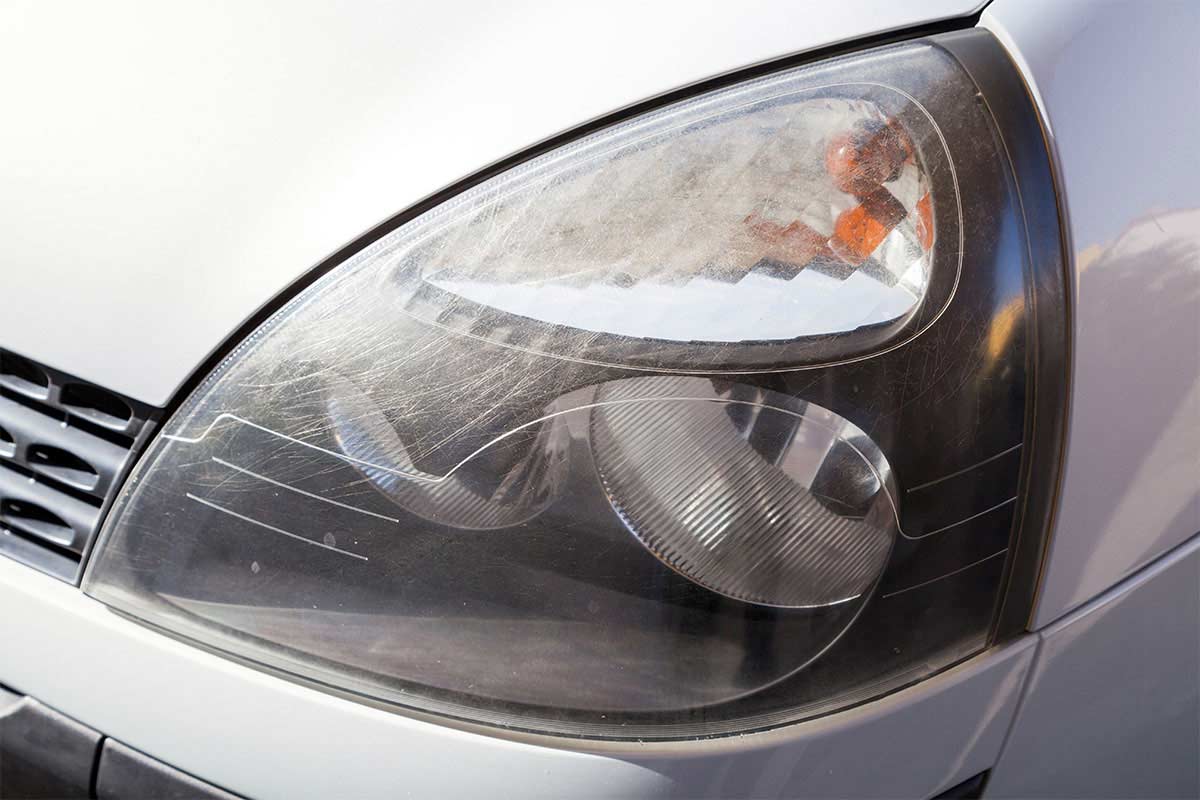
- Clean your windshield. Glass with smudges or streaks on the inside or dirt on the outside make it even harder to see when it’s dark. You’ll also get tired quicker from straining to see.
- Dirty mirrors can increase glare. Clean your side mirrors and adjust them slightly downward so you can keep glare from other cars’ headlights out of your eyes.
- Refer to our summer road trip checklist or winter road trip checklist to make sure everything else on your vehicle is ready.
While You’re Underway
- Turn your headlights on an hour before the sun goes down and keep them on an hour after dawn. This improves your visibility to other drivers when the sun is low in the sky.
- Stay within the speed limit. You can’t see as far at night. With your low beams on, you can only see a maximum of about 250 feet in front of you on unlit roads. You’ll need that much or more to come to a stop, depending on your speed and the road conditions.
- Keep alert by frequently checking all your mirrors. Staring straight ahead for long periods will strain your eyes and lower your attention level.
- Don’t fight drooping eyelids or wait until you’re nodding off to stop. Do something to get your blood flowing and increase your attention, like doing a few stretches or taking a short walk. Get yourself a cup of coffee, or even take a short nap.

- Any time you need to stop, pull as far over onto the shoulder as you safely can and turn on your hazard lights.
- Clean your windshield whenever you make a pit stop or fill up your gas tank. Extra wiper fluid and a clean towel or some rags are good items to have in a road trip safety kit. Create one for summer and one for winter.
- Increase your following distance. Know that feeling when someone is tailgating you with their headlights shining into your rear-view mirror? It’s nerve-racking and the glare in your eyes can make it even harder to see potential problems ahead or by the roadside. Give yourself and others enough space to react.
- Watch roadsides for the reflections of animals’ eyes. Slow way down if you spot them. If you see one deer, there are likely others, so go slowly to be sure you’re past them all.

Photo by Oregon Department of Transportation
Deer at night Uploaded by AlbertHerring [CC BY 2.0 (http://creativecommons.org/licenses/by/2.0)], via Wikimedia Commons- Turn off interior lights. They can create glare that makes it harder to see the road.
- Dim your dashboard lights.
- Keep your car clear of cigarette smoke. It reduces vision.
- Don’t look directly into oncoming headlights. If light from a car coming the other way is blinding or creates glare, watch the white fog line on the right side of the road. You’ll still be able to see the oncoming traffic through peripheral vision while staying in your lane.
- Use high beams when there aren’t oncoming cars and it's right for the road conditions (no fog or heavy rain). They let you see about twice as far ahead as your low beams (350 to 500 feet) and expand your field of vision to the road shoulders. You must turn them to back to low at least 500 feet from an approaching vehicle and when you're within 200 to 300 feet of the vehicle you’re following.
- Use your fog lights for better visibility if it’s truly foggy, but don’t if it’s not. Using them when it’s clear out is unsafe for other drivers and may be a traffic violation.
- Only use any auxiliary lights you’ve mounted on your vehicle if they’re approved for road use. They can blind other drivers and make it hard for your eyes to adjust when you switch down to regular beams.
- If your rearview mirror has a night setting, use it.
- When you see signs for construction zones, be prepared for redirected traffic lanes, equipment and rough roads.
- Be on the lookout for people on foot or bike. Not everyone knows to wear reflective gear.

- Put down your cellphone. It’s a dangerous distraction, day or night, and it’s a traffic violation in many states to use your cell while driving.
- Above all, be a defensive driver during weekend nights, when there are more drunk drivers on the road.
Night driving can be a great way to beat the traffic and enjoy a little peace and quiet. Just be prepared and drive smart.
Get a free pre-trip safety check at any Les Schwab Tires.
-
7 Things To Do When Your Car is Stuck in Snow
A blizzard is on the way. You’ve stocked up on candles, hot cocoa and batteries. But what if you have to leave the house? Do you know how to get your car out of the snow if you get stuck?
From driving techniques to using props, here are seven ways to get your car moving again, plus some advice about how to prepare for a snowstorm.
Before It Snows
There are two key things to do BEFORE the storm arrives to be sure you can get your vehicle back on the road after a big snow. They can make the difference between looking like a genius and having huge hassles.
Have the right tires in the right condition.
If you live somewhere where storms can bring a foot or two of snow at once, you should definitely be running snow tires, not all-season tires. (Find out how to choose snow tires.) Before the snow starts falling, get your air pressure checked and make sure your tire tread’s in the proper condition.
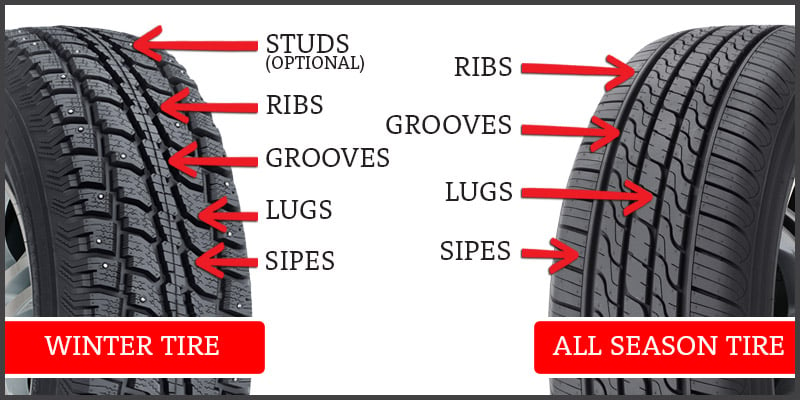
Keep a snow shovel in your vehicle.
Not only will this come in handy for you, but you may also be a hero to those who are caught unprepared. (Speaking of preparedness, here’s a winter safety kit checklist of other items to keep in your car so you’re ready for pretty much any winter road condition.)
Before You Turn Your Vehicle On
Turn off traction control.
Both drive wheels will need to have traction for you to get unstuck. These are the front tires on a front-wheel-drive and the rear tires on rear-wheel drive, AWD and 4WD vehicles. Turn off the car’s traction control system (usually with a button somewhere on the dashboard or console).
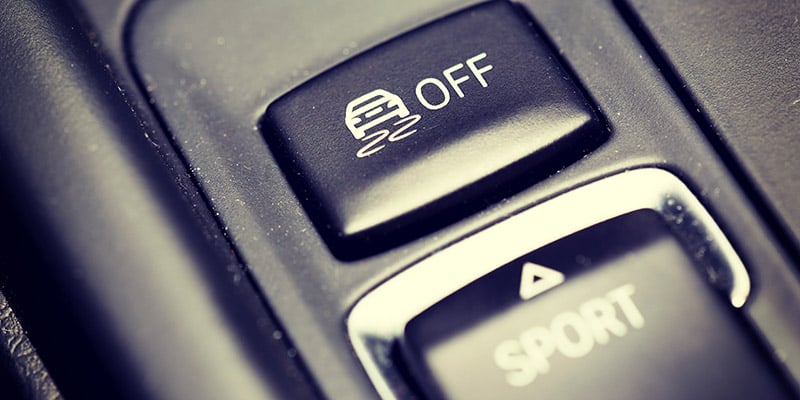
Clear a path around the tires.
- Starting with the drive tires, dig the snow out from in front, underneath and in back. Clear a path long enough for wheels to move forward and back a few feet, assuming you have that much space on either end of the car. Remove any snow around the tires that’s higher than the ground clearance of the car. Dig out snow from under the front of your car. If you’re high-centered, with snow or ice under the vehicle blocking your exit, you won’t be going anywhere.
If you don’t have a shovel handy, try using a screwdriver, ice scraper or another tool to at least break up any ice that’s formed below the tires. A rougher surface area provides more traction. - Also dig out the tailpipe before you start the engine. People have lost their lives from carbon monoxide building up inside a vehicle when they didn’t know the exhaust pipe was blocked.
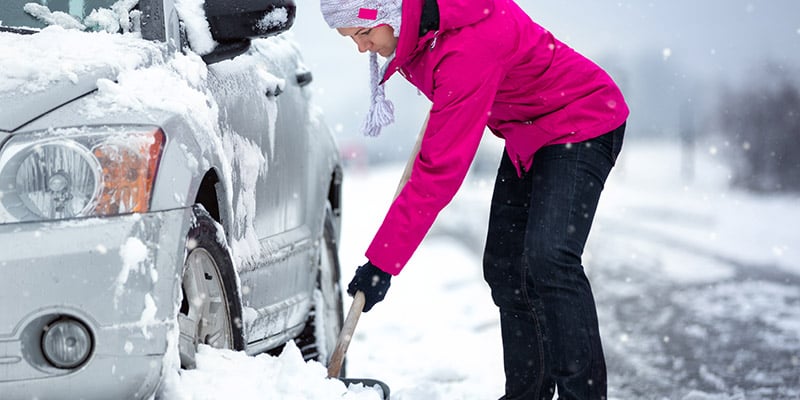
1. The Forward-and-Back Technique
Start your vehicle, roll down your window and take off your hat or earmuffs so you can hear clearly. Even better, stick your head out the window to watch your front tire. You’ll get the best traction by straightening the wheel, so do this as much as your parking situation allows.
Put your vehicle in the lowest gear. If you’ve got a four-wheel drive SUV or pickup, engage the low-range gearing. Move forward just a bit.
Now slowly back up. Don’t rev the engine. Stop, then put it in forward and apply a little gas. This can tamp down loose snow and maybe give you enough traction to get out.
Listen carefully. If you hear any tire spinning, take your foot off the gas immediately.
2. The Braking Technique
If your vehicle didn’t move at all or a tire is spinning, try braking while at the same time that you’re giving a little gas. This should decrease the spinning and transfer some power to that wheel.
If you have a front-wheel-drive and there aren’t curbs or other cars blocking your way, try turning the wheels slightly the other way and see if that gives you more traction.
Don’t try this braking method for more than a few seconds. It can overheat your brakes which can compromise braking until they’ve cooled down.
3. Find Some Muscle
Sometimes a push from a few Good Samaritans will do the trick. Be 100 percent sure you use only the gear that keeps pushers out of harm’s way (Forward gear only if they're pushing your vehicle from behind.). Ask your helpers to push on the count of three as you gently apply the gas.
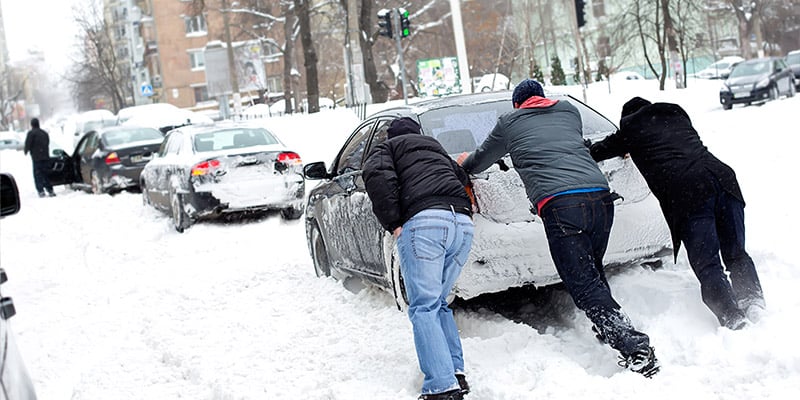
4. Use Snow Chains
If you’re still stuck and you have snow chains, it’s time to chain up. That almost always does the trick.
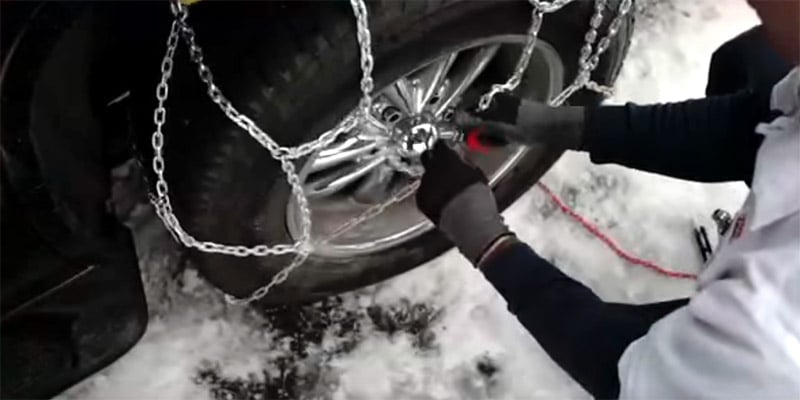
5. The Rocking Technique
If you don’t have chains, and your vehicle is moving forward some but then stopping, try “rocking” back and forth between forward and reverse gears. Give it a little gas just as the vehicle starts to swing forward out of reverse. This may give you enough momentum to drive out. But be aware that this kind of rapid shifting can overload your transmission. Only try it a few times or you could end up with expensive damage. It will be much cheaper to just call a tow truck.
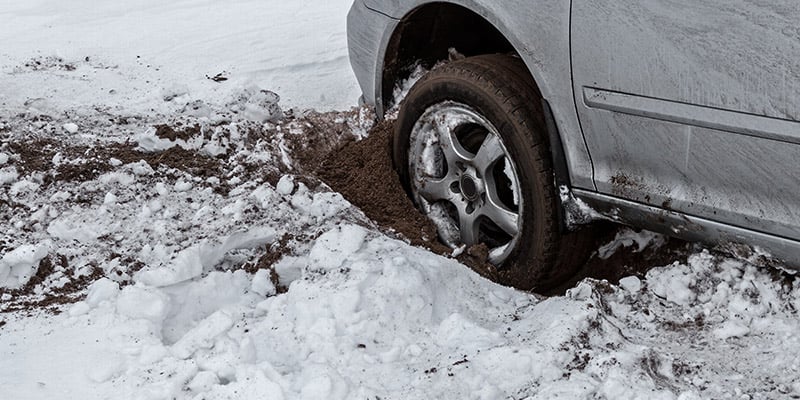
6. Add Traction with Sand, Kitty Litter or Cardboard
If you’re still spinning, you can put something on the ground to add traction that won’t damage your tires. Try sprinkling sand or kitty litter in front of the drive tires (and behind them if you’re planning on backing out).
DON’T EVER USE ANTIFREEZE TO TRY TO MELT SNOW AND ICE. Antifreeze is toxic to children, pets, and wild animals, and it can find its way through storm drains to waterways where it can poison marine animals. Plus, in some states, it’s illegal to pour antifreeze on the ground. Using salt as a deicer is also a bad idea for the environment — and your vehicle. It’s corrosive to metal (like the undercarriage of your car) and becomes less effective below 25 degrees Fahrenheit anyway.
Another way to get traction is to lay cardboard, plywood, two-by-fours or even your vehicle’s floor mats down in front of the drive tires (or behind them if you’re starting in reverse). If you’re in the middle of nowhere, you can use weeds or branches from the side of the road. But caution: Clear the area and go very easy when accelerating. Sometimes the wheels can make whatever you put down for traction shoot out. And be aware your mats could get ruined. Again, it’s probably less out of your pocketbook to get a tow truck.
7. Let a Bit of Air Out of Your Tires
The last resort is to let a little air out of your tires, just enough so they look visibly lower. Only do this if you have a way to get them quickly refilled someplace close by. Driving on underinflated tires puts more rubber in contact with the ground and will give you better traction for a short distance. But driving this way isn’t safe and it could damage your tires if it’s a long way to the filling station.
![Letting air out of a tire]](https://www.lesschwab.com/on/demandware.static/-/Library-Sites-LesSchwabLibrary/default/dw9d975f34/images/learningCenter/article/content/les-schwab-deflate-tire.jpg )
Be Prepared When Your Car Does Break Free
If you’re in forward gear, don’t stop right away but drive somewhere you can see there’s less snow and you can safely stop. If you’re in reverse, keep backing up for a few yards, then take your foot off the gas. The snow will stop you. Next, put it in low gear and gently accelerate forward in the tracks you’ve made, just fast enough to break through where you were stuck.
Once You’re Unstuck from the Snow
Re-engage your traction control system, if you turned it off. If you engaged your low-range 4WD, disengage. Make sure your radiator has air flow. Snow packed into the front of the grille can cause engine overheating.
Go immediately to the closest service station and refill your tires if you let any air out.
If you notice a vibration in your steering wheel, check for snow packed into your wheels. Pull over someplace safe and knock the snow or ice out with an ice scraper or shovel.
Want a complete list of resources for winter driving safety? Here’s our guide for safe driving in winter, from prepping your vehicle to driving in bad conditions.
Important Notice: The information provided above is from a variety of resources deemed reasonably reliable. The operation of your vehicle, or the repair or replacement of your vehicle’s equipment, may be different than for a typical vehicle. Please consult your owner’s manual for specific warnings, notices, and other advice relative to the above.
Get More Driving Tips - Starting with the drive tires, dig the snow out from in front, underneath and in back. Clear a path long enough for wheels to move forward and back a few feet, assuming you have that much space on either end of the car. Remove any snow around the tires that’s higher than the ground clearance of the car. Dig out snow from under the front of your car. If you’re high-centered, with snow or ice under the vehicle blocking your exit, you won’t be going anywhere.
-
What You Need to Know About Road Conditions Right Now
If you’re traveling by car this winter, you’re going to want to bookmark the following guide for Western states, so you can find out what you need to know about road conditions right now. See current road reports, Road Cams, chain requirements, Weather Reports and Winter Storm Warnings for Alaska, California, Colorado, Idaho, Minnesota, Montana, Nevada, North Dakota, Oregon, South Dakota, Utah, Washington, and Wyoming.
Guide to Real-time Road Conditions in Western States
For more on winter road safety, see our guide 19 Winter Driving Resources You Can’t Do Without.